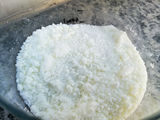Guanidinium nitrate
 Slightly impure guanidine nitrate
| |
| Names | |
|---|---|
| IUPAC name
Guanidinium nitrate
| |
| Other names
Guanidine nitrate
Guanidine, nitric acid salt | |
| Properties | |
| CH6N4O3 C(NH2)3NO3 | |
| Molar mass | 122.1 g/mol |
| Appearance | White solid |
| Odor | Odorless |
| Density | 1.436 g/cm3 |
| Melting point | 213 °C (415 °F; 486 K) (decomposes) |
| Boiling point | Decomposes |
| 16 g/100 ml (20 °C) | |
| Solubility | Slightly soluble in acetone, alcohols |
| Vapor pressure | ~0 mmHg |
| Hazards | |
| Safety data sheet | Sigma-Aldrich |
| Lethal dose or concentration (LD, LC): | |
| LD50 (Median dose)
|
730 mg/kg (rat, oral) |
| Related compounds | |
| Related compounds
|
Guanidinium carbonate Guanidinium chloride Guanidinium perchlorate Guanidinium sulfate |
| Except where otherwise noted, data are given for materials in their standard state (at 25 °C [77 °F], 100 kPa). | |
| Infobox references | |
Guanidinium nitrate, also (incorrectly) referred to as guanidine nitrate (or GdnNO3), is a colorless solid, the nitrate salt of guanidine, used as rocket fuel. It has the formula CH6N3NO3 or C(NH2)3NO3.
Contents
Properties
Chemical
Guanidinium nitrate is a powerful energetic material, widely used as rocket propellant. It will burn when ignited and may explode if detonated. The decomposition reaction is the following:
- CH6N4O3 (s) → 3 H2O (g) + 2 N2 (g) + C (s)
Physical
Guanidinium nitrate is an odorless white solid, soluble in water, but insoluble in many organic solvents, like hydrocarbons.
Explosive
At high temperatures, guanidine nitrate can explode. It has an average detonation velocity of 2,762 m/s[1], or 3700 m/s[2]. Unlike the decomposition of ammonium or urea nitrate, the decomposition of GdnNO3 is influenced by bases and acids.[3]
It has been used as a monopropellant in the Jetex engine for model airplanes. It is attractive because it has a high gas output and low flame temperature. It has a relatively high monopropellant specific impulse of 177 seconds (1.7 kN·s/kg).
Availability
Guanidine nitrate is sold by chemical suppliers, though it's not easy to acquire.
Preparation
Guanidinium nitrate can be made by melting a mixture of ammonium nitrate, urea with silica gel. All reagents must be dry and well mixed. When the temperature reaches 160 °C, the molten mixture begins to foam and releases ammonia. To prevent the reagents from spilling all over your table, you will have to strongly stir the mixture for at least a couple of hours.[4] The use of silica gel is absolutely necessary, as molten ammonium nitrate mixed with another organic material may explode if the mixture is too pure or the temperature is too high.
Two reactions occur during the process:
- NH4NO3 + (NH2)2CO → C(NH2)3NO3 + NH4COONH2
- NH4COONH2 → 2 NH3 + CO2
A different method replaces urea with calcium cyanamide.
While it can be made by reacting stoichiometric amounts of guanidine with nitric acid, freebase guanidine is difficult to find. Guanidinium carbonate or bicarbonate can be used instead as they're cheaper and more available.
Projects
- Rocket propellant
- Make tetrazoles
- Make nitroguanidine
- Make guanidinium aluminium sulfate hexahydrate
Handling
Safety
Guanidinium nitrate is flammable and can explode at high temperatures.
Storage
In closed containers, away from any fire source.
Disposal
Guanidinium nitrate can be used as fertilizer, as long as you dilute it with water.
Gallery
References
- ↑ TECHNICAL REPORT ARLCD-TR-78062, p. 19
- ↑ Encyclopedia of Explosives and Related Items Vol 10; Ed Kaye, S.M. U.S. Army Armament Research and Development Command; 1983; pp U 102-105.
- ↑ http://energetics.chm.uri.edu/system/files/Decomposition%20of%20Urea%20NitrateJEMFEB08MS%2523543r0_1.pdf
- ↑ https://www.youtube.com/watch?v=QK_zsRBlkt0
